torque FIAT PANDA 2016 319 / 3.G Owners Manual
[x] Cancel search | Manufacturer: FIAT, Model Year: 2016, Model line: PANDA, Model: FIAT PANDA 2016 319 / 3.GPages: 204, PDF Size: 18.77 MB
Page 63 of 204
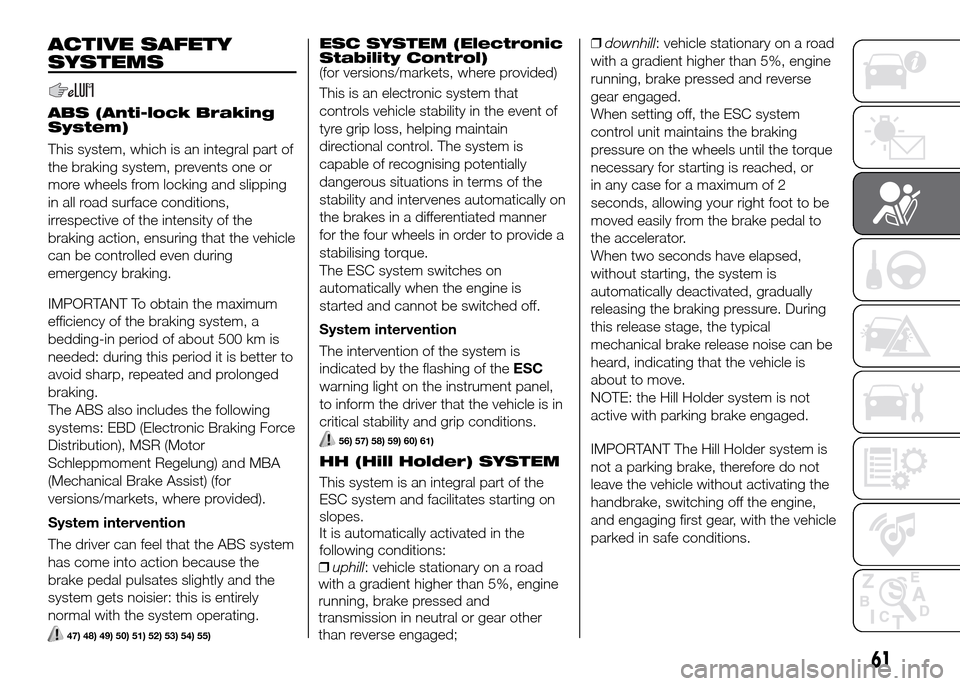
ACTIVE SAFETY
SYSTEMS
ABS (Anti-lock Braking
System)
This system, which is an integral part of
the braking system, prevents one or
more wheels from locking and slipping
in all road surface conditions,
irrespective of the intensity of the
braking action, ensuring that the vehicle
can be controlled even during
emergency braking.
IMPORTANT To obtain the maximum
efficiency of the braking system, a
bedding-in period of about 500 km is
needed: during this period it is better to
avoid sharp, repeated and prolonged
braking.
The ABS also includes the following
systems: EBD (Electronic Braking Force
Distribution), MSR (Motor
Schleppmoment Regelung) and MBA
(Mechanical Brake Assist) (for
versions/markets, where provided).
System intervention
The driver can feel that the ABS system
has come into action because the
brake pedal pulsates slightly and the
system gets noisier: this is entirely
normal with the system operating.ESC SYSTEM (Electronic
Stability Control)
(for versions/markets, where provided)
This is an electronic system that
controls vehicle stability in the event of
tyre grip loss, helping maintain
directional control. The system is
capable of recognising potentially
dangerous situations in terms of the
stability and intervenes automatically on
the brakes in a differentiated manner
for the four wheels in order to provide a
stabilising torque.
The ESC system switches on
automatically when the engine is
started and cannot be switched off.
System intervention
The intervention of the system is
indicated by the flashing of theESC
warning light on the instrument panel,
to inform the driver that the vehicle is in
critical stability and grip conditions.
56) 57) 58) 59) 60) 61)
HH (Hill Holder) SYSTEM
This system is an integral part of the
ESC system and facilitates starting on
slopes.
It is automatically activated in the
following conditions:
❒uphill: vehicle stationary on a road
with a gradient higher than 5%, engine
running, brake pressed and
transmission in neutral or gear other
than reverse engaged;❒downhill: vehicle stationary on a road
with a gradient higher than 5%, engine
running, brake pressed and reverse
gear engaged.
When setting off, the ESC system
control unit maintains the braking
pressure on the wheels until the torque
necessary for starting is reached, or
in any case for a maximum of 2
seconds, allowing your right foot to be
moved easily from the brake pedal to
the accelerator.
When two seconds have elapsed,
without starting, the system is
automatically deactivated, gradually
releasing the braking pressure. During
this release stage, the typical
mechanical brake release noise can be
heard, indicating that the vehicle is
about to move.
NOTE: the Hill Holder system is not
active with parking brake engaged.
IMPORTANT The Hill Holder system is
not a parking brake, therefore do not
leave the vehicle without activating the
handbrake, switching off the engine,
and engaging first gear, with the vehicle
parked in safe conditions.
61
47) 48) 49) 50) 51) 52) 53) 54) 55)
Page 65 of 204
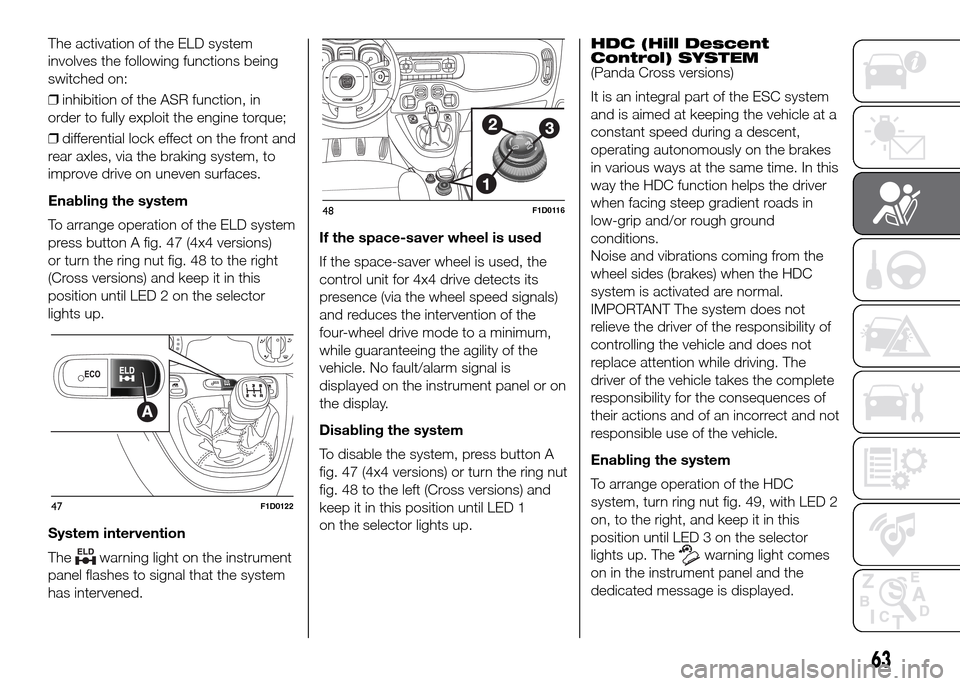
The activation of the ELD system
involves the following functions being
switched on:
❒inhibition of the ASR function, in
order to fully exploit the engine torque;
❒differential lock effect on the front and
rear axles, via the braking system, to
improve drive on uneven surfaces.
Enabling the system
To arrange operation of the ELD system
press button A fig. 47 (4x4 versions)
or turn the ring nut fig. 48 to the right
(Cross versions) and keep it in this
position until LED 2 on the selector
lights up.
System intervention
The
warning light on the instrument
panel flashes to signal that the system
has intervened.If the space-saver wheel is used
If the space-saver wheel is used, the
control unit for 4x4 drive detects its
presence (via the wheel speed signals)
and reduces the intervention of the
four-wheel drive mode to a minimum,
while guaranteeing the agility of the
vehicle. No fault/alarm signal is
displayed on the instrument panel or on
the display.
Disabling the system
To disable the system, press button A
fig. 47 (4x4 versions) or turn the ring nut
fig. 48 to the left (Cross versions) and
keep it in this position until LED 1
on the selector lights up.HDC (Hill Descent
Control) SYSTEM
(Panda Cross versions)
It is an integral part of the ESC system
and is aimed at keeping the vehicle at a
constant speed during a descent,
operating autonomously on the brakes
in various ways at the same time. In this
way the HDC function helps the driver
when facing steep gradient roads in
low-grip and/or rough ground
conditions.
Noise and vibrations coming from the
wheel sides (brakes) when the HDC
system is activated are normal.
IMPORTANT The system does not
relieve the driver of the responsibility of
controlling the vehicle and does not
replace attention while driving. The
driver of the vehicle takes the complete
responsibility for the consequences of
their actions and of an incorrect and not
responsible use of the vehicle.
Enabling the system
To arrange operation of the HDC
system, turn ring nut fig. 49, with LED 2
on, to the right, and keep it in this
position until LED 3 on the selector
lights up. Thewarning light comes
on in the instrument panel and the
dedicated message is displayed.
47F1D0122
48F1D0116
63
Page 97 of 204
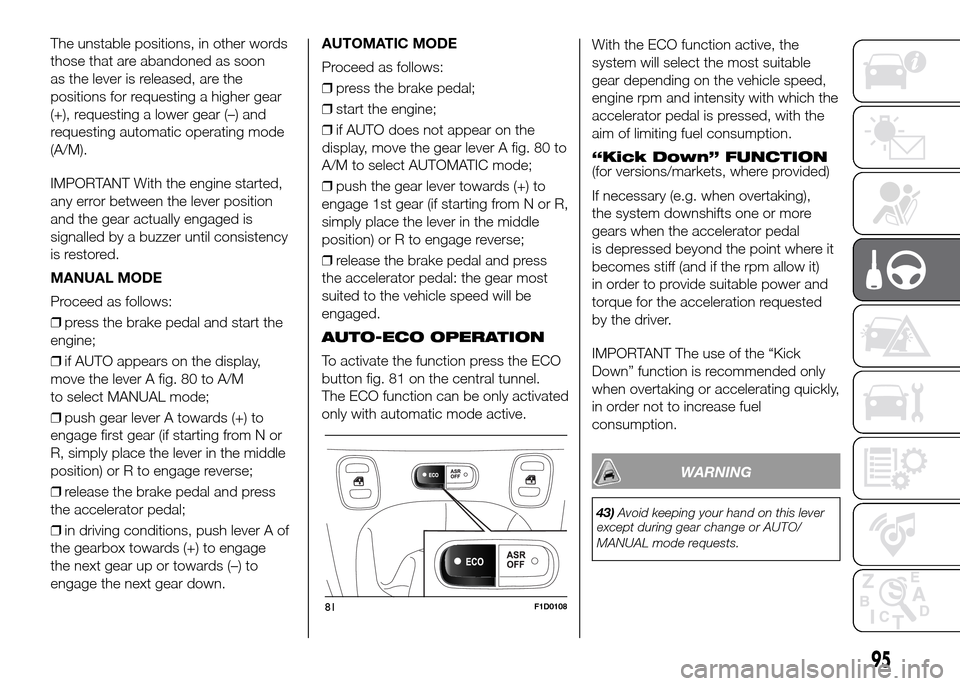
The unstable positions, in other words
those that are abandoned as soon
as the lever is released, are the
positions for requesting a higher gear
(+), requesting a lower gear (–) and
requesting automatic operating mode
(A/M).
IMPORTANT With the engine started,
any error between the lever position
and the gear actually engaged is
signalled by a buzzer until consistency
is restored.
MANUAL MODE
Proceed as follows:
❒press the brake pedal and start the
engine;
❒if AUTO appears on the display,
move the lever A fig. 80 to A/M
to select MANUAL mode;
❒push gear lever A towards (+) to
engage first gear (if starting from N or
R, simply place the lever in the middle
position) or R to engage reverse;
❒release the brake pedal and press
the accelerator pedal;
❒in driving conditions, push lever A of
the gearbox towards (+) to engage
the next gear up or towards (–) to
engage the next gear down.AUTOMATIC MODE
Proceed as follows:
❒press the brake pedal;
❒start the engine;
❒if AUTO does not appear on the
display, move the gear lever A fig. 80 to
A/M to select AUTOMATIC mode;
❒push the gear lever towards (+) to
engage 1st gear (if starting from N or R,
simply place the lever in the middle
position) or R to engage reverse;
❒release the brake pedal and press
the accelerator pedal: the gear most
suited to the vehicle speed will be
engaged.
AUTO-ECO OPERATION
To activate the function press the ECO
button fig. 81 on the central tunnel.
The ECO function can be only activated
only with automatic mode active.
81F1D0108
95
With the ECO function active, the
system will select the most suitable
gear depending on the vehicle speed,
engine rpm and intensity with which the
accelerator pedal is pressed, with the
aim of limiting fuel consumption.
“Kick Down” FUNCTION
(for versions/markets, where provided)
If necessary (e.g. when overtaking),
the system downshifts one or more
gears when the accelerator pedal
is depressed beyond the point where it
becomes stiff (and if the rpm allow it)
in order to provide suitable power and
torque for the acceleration requested
by the driver.
IMPORTANT The use of the “Kick
Down” function is recommended only
when overtaking or accelerating quickly,
in order not to increase fuel
consumption.
WARNING
43)Avoid keeping your hand on this lever
except during gear change or AUTO/
MANUAL mode requests.
Page 127 of 204
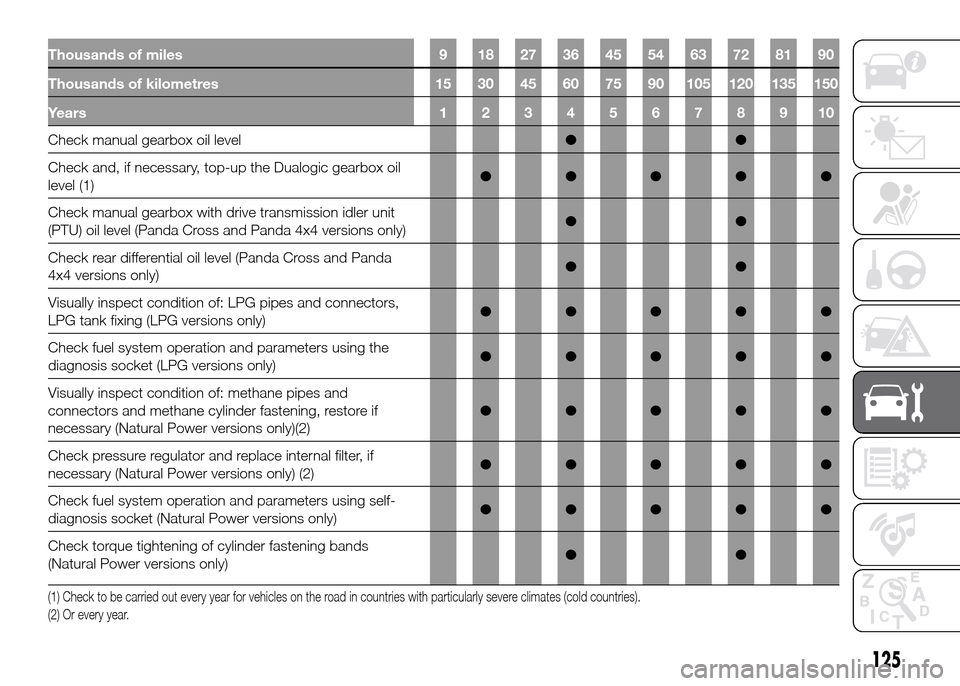
Thousands of miles 9 18 27 36 45 54 63 72 81 90
Thousands of kilometres 15 30 45 60 75 90 105 120 135 150
Years12345678910
Check manual gearbox oil level●●
Check and, if necessary, top-up the Dualogic gearbox oil
level (1)●●●●●
Check manual gearbox with drive transmission idler unit
(PTU) oil level (Panda Cross and Panda 4x4 versions only)●●
Check rear differential oil level (Panda Cross and Panda
4x4 versions only)●●
Visually inspect condition of: LPG pipes and connectors,
LPG tank fixing (LPG versions only)●●●●●
Check fuel system operation and parameters using the
diagnosis socket (LPG versions only)●●●●●
Visually inspect condition of: methane pipes and
connectors and methane cylinder fastening, restore if
necessary (Natural Power versions only)(2)●●●●●
Check pressure regulator and replace internal filter, if
necessary (Natural Power versions only) (2)●●●●●
Check fuel system operation and parameters using self-
diagnosis socket (Natural Power versions only)●●●●●
Check torque tightening of cylinder fastening bands
(Natural Power versions only)●●
(1) Check to be carried out every year for vehicles on the road in countries with particularly severe climates (cold countries).
(2) Or every year.
125
Page 145 of 204
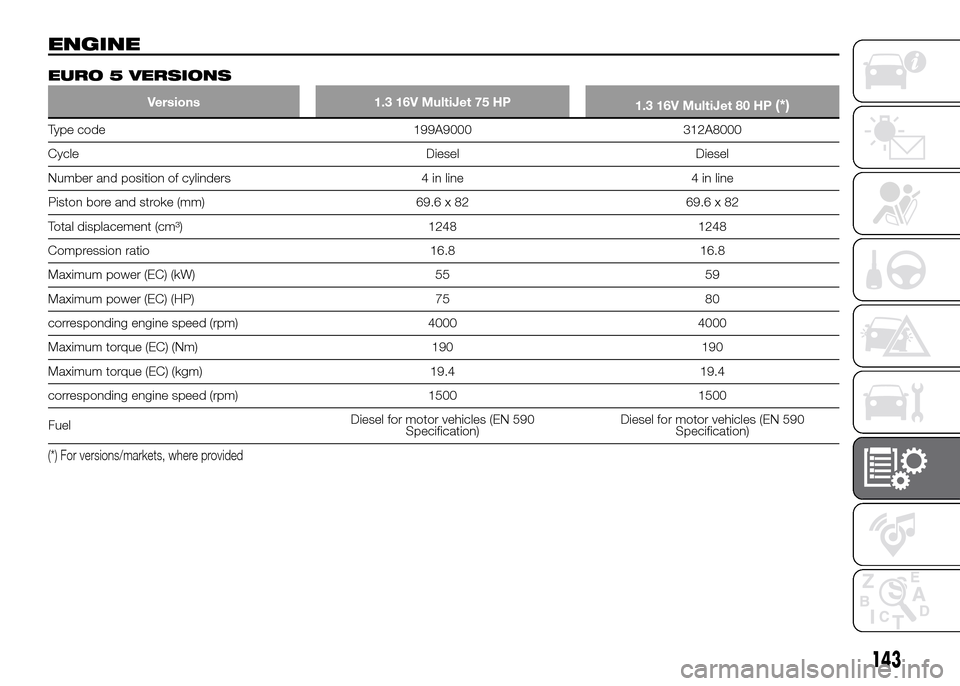
ENGINE
EURO 5 VERSIONS
Versions 1.3 16V MultiJet 75 HP
1.3 16V MultiJet 80 HP(*)
Type code 199A9000 312A8000
Cycle Diesel Diesel
Number and position of cylinders 4 in line 4 in line
Piston bore and stroke (mm) 69.6 x 82 69.6 x 82
Total displacement (cm³) 1248 1248
Compression ratio 16.8 16.8
Maximum power (EC) (kW) 55 59
Maximum power (EC) (HP) 75 80
corresponding engine speed (rpm) 4000 4000
Maximum torque (EC) (Nm) 190 190
Maximum torque (EC) (kgm) 19.4 19.4
corresponding engine speed (rpm) 1500 1500
FuelDiesel for motor vehicles (EN 590
Specification)Diesel for motor vehicles (EN 590
Specification)
(*) For versions/markets, where provided
143
Page 146 of 204
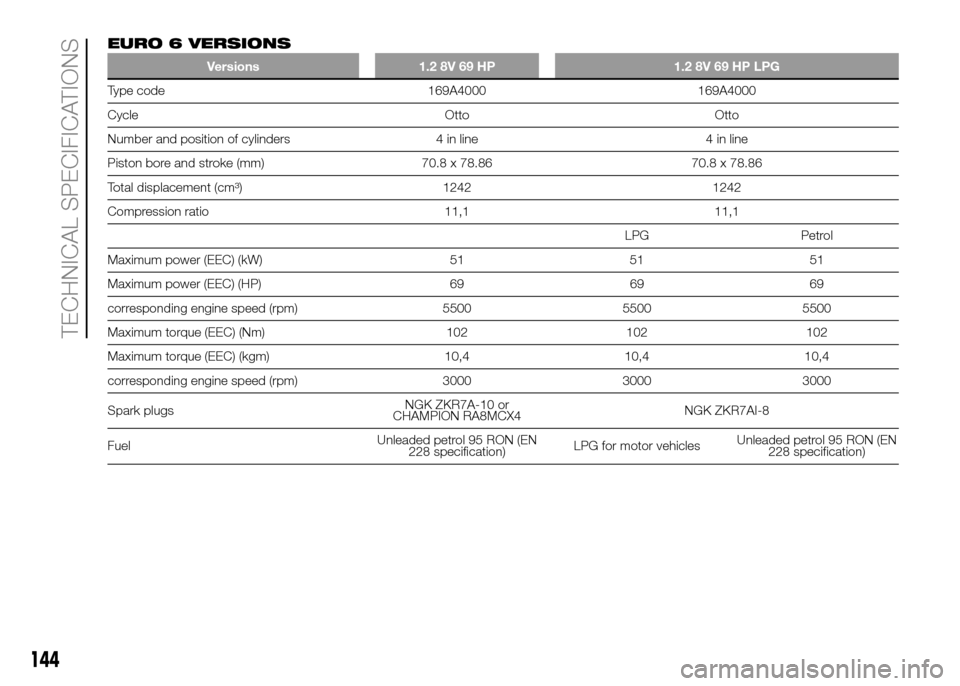
EURO 6 VERSIONS
Versions 1.2 8V 69 HP 1.2 8V 69 HP LPG
Type code 169A4000 169A4000
Cycle Otto Otto
Number and position of cylinders 4 in line 4 in line
Piston bore and stroke (mm) 70.8 x 78.86 70.8 x 78.86
Total displacement (cm³) 1242 1242
Compression ratio 11,1 11,1
LPG Petrol
Maximum power (EEC) (kW) 51 51 51
Maximum power (EEC) (HP) 69 69 69
corresponding engine speed (rpm) 5500 5500 5500
Maximum torque (EEC) (Nm) 102 102 102
Maximum torque (EEC) (kgm) 10,4 10,4 10,4
corresponding engine speed (rpm) 3000 3000 3000
Spark plugsNGK ZKR7A-10 or
CHAMPION RA8MCX4NGK ZKR7AI-8
FuelUnleaded petrol 95 RON (EN
228 specification)LPG for motor vehiclesUnleaded petrol 95 RON (EN
228 specification)
144
TECHNICAL SPECIFICATIONS
Page 147 of 204
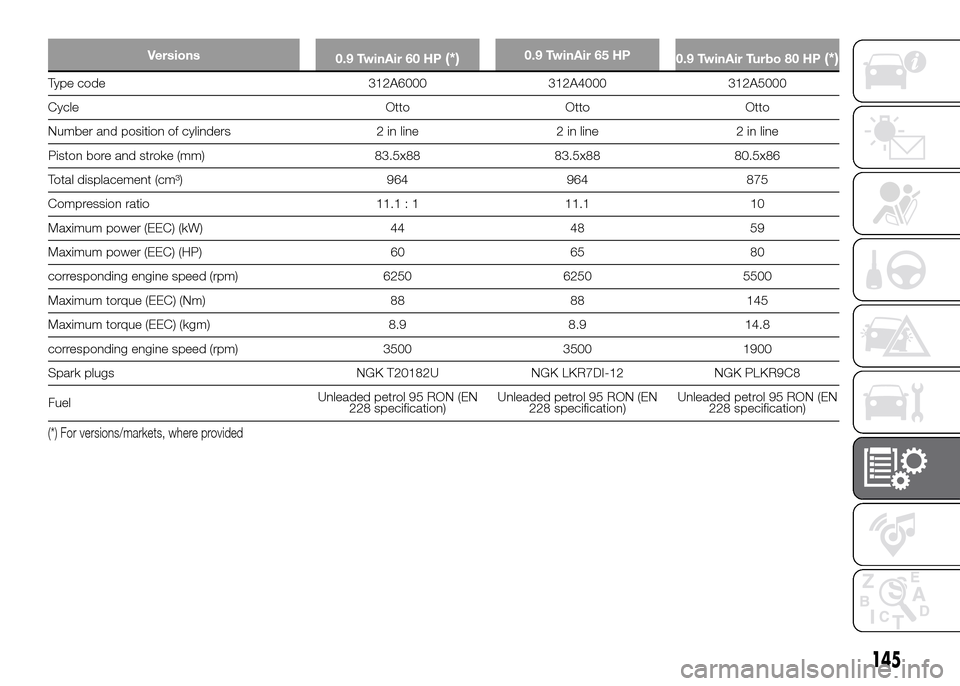
Versions
0.9 TwinAir 60 HP(*)0.9 TwinAir 65 HP
0.9 TwinAir Turbo 80 HP(*)
Type code 312A6000 312A4000 312A5000
Cycle Otto Otto Otto
Number and position of cylinders 2 in line 2 in line 2 in line
Piston bore and stroke (mm) 83.5x88 83.5x88 80.5x86
Total displacement (cm³) 964 964 875
Compression ratio 11.1 : 1 11.1 10
Maximum power (EEC) (kW) 44 48 59
Maximum power (EEC) (HP) 60 65 80
corresponding engine speed (rpm) 6250 6250 5500
Maximum torque (EEC) (Nm) 88 88 145
Maximum torque (EEC) (kgm) 8.9 8.9 14.8
corresponding engine speed (rpm) 3500 3500 1900
Spark plugs NGK T20182U NGK LKR7DI-12 NGK PLKR9C8
FuelUnleaded petrol 95 RON (EN
228 specification)Unleaded petrol 95 RON (EN
228 specification)Unleaded petrol 95 RON (EN
228 specification)
(*) For versions/markets, where provided
145
Page 148 of 204
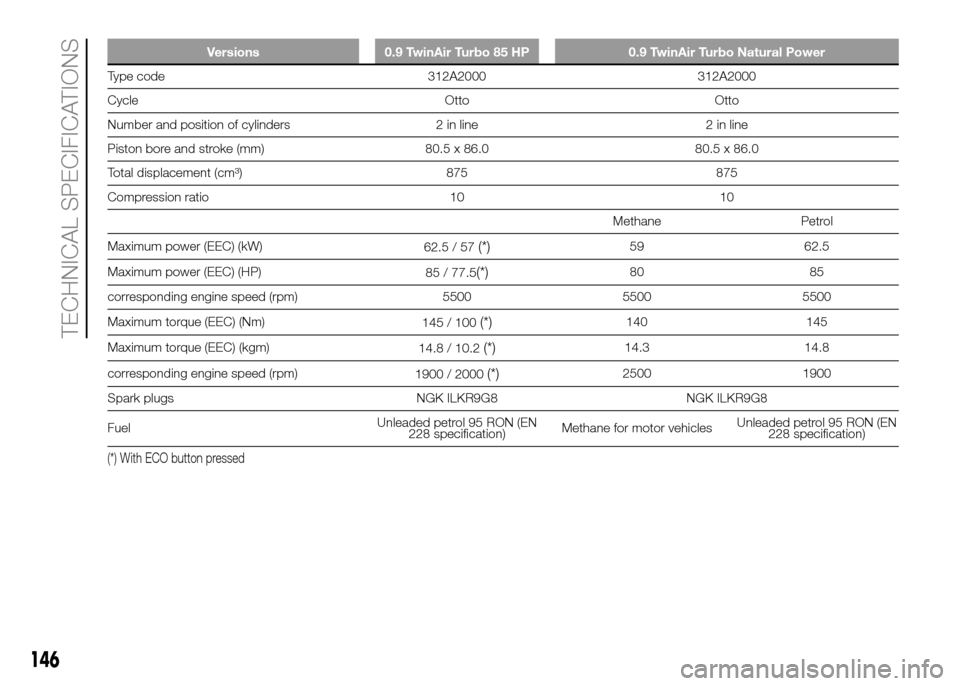
Versions 0.9 TwinAir Turbo 85 HP 0.9 TwinAir Turbo Natural Power
Type code 312A2000 312A2000
Cycle Otto Otto
Number and position of cylinders 2 in line 2 in line
Piston bore and stroke (mm) 80.5 x 86.0 80.5 x 86.0
Total displacement (cm³) 875 875
Compression ratio 10 10
Methane Petrol
Maximum power (EEC) (kW)
62.5 / 57
(*)59 62.5
Maximum power (EEC) (HP)
85 / 77.5
(*)80 85
corresponding engine speed (rpm) 5500 5500 5500
Maximum torque (EEC) (Nm)
145 / 100
(*)140 145
Maximum torque (EEC) (kgm)
14.8 / 10.2
(*)14.3 14.8
corresponding engine speed (rpm)
1900 / 2000
(*)2500 1900
Spark plugs NGK ILKR9G8 NGK ILKR9G8
FuelUnleaded petrol 95 RON (EN
228 specification)Methane for motor vehiclesUnleaded petrol 95 RON (EN
228 specification)
(*) With ECO button pressed
146
TECHNICAL SPECIFICATIONS
Page 149 of 204
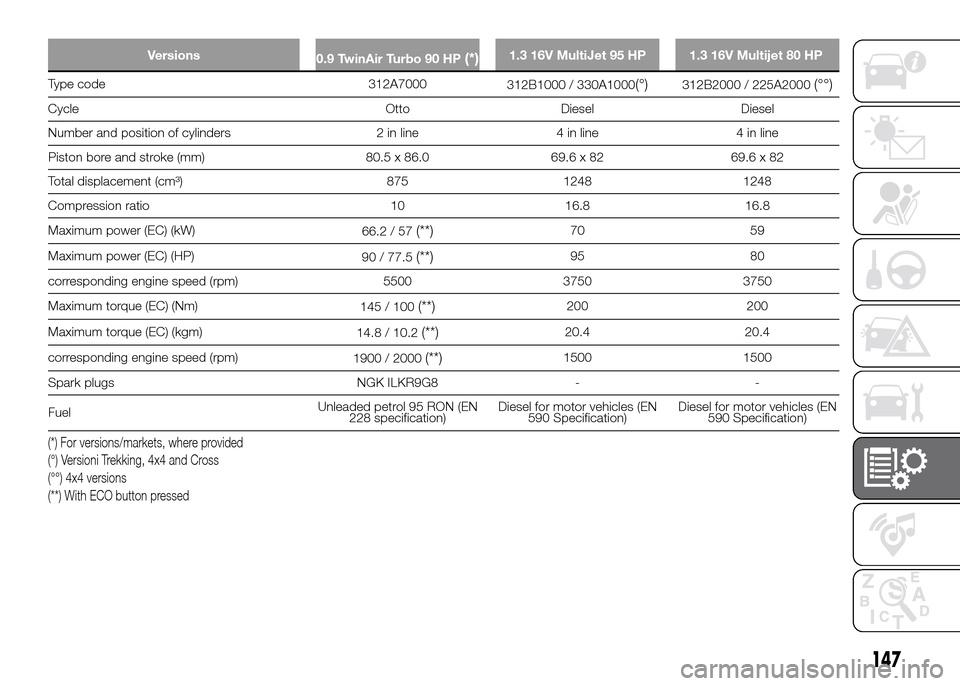
Versions
0.9 TwinAir Turbo 90 HP(*)1.3 16V MultiJet 95 HP 1.3 16V Multijet 80 HP
Type code 312A7000
312B1000 / 330A1000(°)312B2000 / 225A2000(°°)
Cycle Otto Diesel Diesel
Number and position of cylinders 2 in line 4 in line 4 in line
Piston bore and stroke (mm) 80.5 x 86.0 69.6 x 82 69.6 x 82
Total displacement (cm³) 875 1248 1248
Compression ratio 10 16.8 16.8
Maximum power (EC) (kW)
66.2 / 57
(**)70 59
Maximum power (EC) (HP)
90 / 77.5
(**)95 80
corresponding engine speed (rpm) 5500 3750 3750
Maximum torque (EC) (Nm)
145 / 100
(**)200 200
Maximum torque (EC) (kgm)
14.8 / 10.2
(**)20.4 20.4
corresponding engine speed (rpm)
1900 / 2000
(**)1500 1500
Spark plugs NGK ILKR9G8 - -
FuelUnleaded petrol 95 RON (EN
228 specification)Diesel for motor vehicles (EN
590 Specification)Diesel for motor vehicles (EN
590 Specification)
(*) For versions/markets, where provided
(°) Versioni Trekking, 4x4 and Cross
(°°) 4x4 versions
(**) With ECO button pressed
147